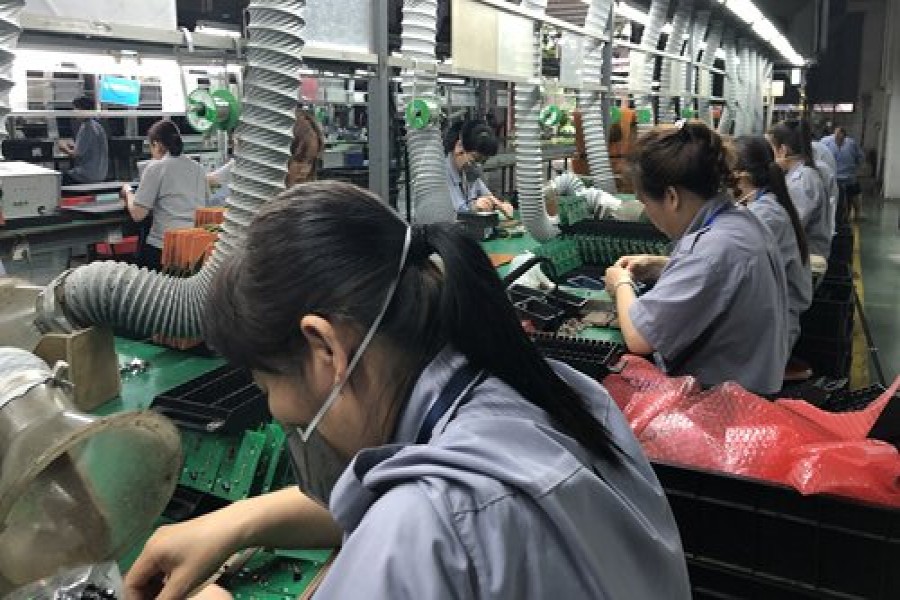The current trade war with the US cannot destroy China's advantages in the supply chain and will in fact help the country's manufacturing base to climb faster and higher up the value chain, Chinese industry insiders noted.
Chinese Premier Li Keqiang said, during a visit to a private company in Weifang, East China's Shandong Province from Friday to Saturday, that Chinese enterprises will ultimately win consumers and markets based on technological innovation, their own efforts and developing broad cooperation.
Chinese officials have repeatedly stressed that although the trade war has had some impacts on Chinese exporters mainly clustered in the Pearl River and Yangtze River deltas, China's two manufacturing hubs oriented toward foreign trade, the impacts are controllable and China has the confidence to pull through.
Wang Zhijun, vice minister of industry and information technology, said the US tariff hike will cause domestic enterprises to face higher operational costs, lower competition and fewer orders, but the impacts were overall controllable, the Xinhua News Agency reported on Sunday.
When asked to comment on the US raising tariffs on $200 billion worth of Chinese goods earlier this month, Wang said the amount accounted for 41.8 per cent of all Chinese exports to the US in 2018, but took up only 8 per cent of all Chinese foreign exports.
Meanwhile, Chinese manufacturers are actively seeking ways out amid the ongoing trade war by either diversifying to other overseas markets or diverting their attention toward the huge domestic market.
Korra Bath Ware Co, a sanitary products producer focused on foreign exports and based in Foshan, South China's Guangdong Province, has been exploring overseas markets in countries and regions along the routes of the China-proposed Belt and Road Initiative (BRI).
"Different from the original equipment manufacturer (OEM) mode applied in the US or European markets, we have our own branded shower rooms and bathtubs sold to the Southeast Asian and African countries," Liu Xiangying, vice general manager of Korra, told the Global Times.
About 60 per cent of Korra's business came from the US market and its cooperation with US customers has been affected to some degree by the China-US trade dispute.
"We want to make it through together and our US customers will not leave China in the short run as it takes time for the supply chain to regroup and reach a balanced state," said Liu.
Korra is exploring transit trade via Southeast Asian countries, but not planning to establish a factory there.
Move or leave?
China has forged, over the past four decades, definite advantages not only in manufacturing highly cost-effective goods for the world, but also in a complete, mature supply chain, experts and entrepreneurs noted.
It was undeniable that more Chinese manufactures have transferred their processing trade or low-end industry to newly emerging Southeast Asian countries such as Vietnam, but that process started prior to the trade war with rising labor costs, said Lin Jiang, an economics professor at Lingnan College, Sun Yat-sen University in Guangzhou, capital of Guangdong Province.
"The trade war only accelerates that process," Lin told the Global Times on Sunday.
Due to the trade war, transnational companies, which have long enjoyed the benefits of China's supply chain and output advantages, might have felt the pinch transferring the production line out of China.
Poor roads, sparse rail lines and congested ports in Vietnam, Thailand, the Philippines, Cambodia and other potential manufacturing destinations in Southeast Asia have stretched out delivery schedules and raised shipping costs, Wall Street Journal reported Thursday, citing manufacturing and transportation company executives.
"Sometimes even for a screw, you need to purchase from Guangdong for a factory in Southeast Asian countries," said Chen Liang, head of Dongguan Magnetic Materials Industry Association.
According to Lin, enterprises used to focus on human costs or land costs in the supply chain, but competition is moving toward intelligent logistics based on big data and fifth-generation (5G) networks - China leads the world in these areas.
"It's important for China to grasp opportunities in the next supply chain wave," he said.
A new start
Zhang Weiqiang, chairman of Zhongyuan Creative, a company based in Foshan, Guangdong, told the Global Times on Friday that his company has been ready to transform toward an innovation center since last year.
"It's a good new start," Zhang said.
Engaged in electric wire manufacturing for four decades, Zhongyuan witnessed its orders placed by US customers, which take up 60 per cent of its overseas sales, decline by over 60 per cent since US tariffs on $34 billion of Chinese goods took effect in August, Zhang said.
"The recently announced tariff hike to 25 per cent on $200 billion worth of Chinese goods further aggravated the order decline," he noted. "It's a good thing, however, because it has reminded me that we have to change now."
The company has adopted a cooperation model with its US partners: Zhongyuan is responsible for original design manufacturing while the US side runs market research and sales, which means that Zhongyuan has little say in business relations.
"Since last year, we have invested in two automatic production lines, aiming to produce what we want by embracing the intelligent manufacturing trend in the country as well as opportunities emerging from the guidelines of the Guangdong-Hong Kong-Macao Greater Bay Area," Zhang said.
He was confident that by ramping up efforts in self-reliant technological innovation and enhancing the influence of their own brand, the company was bound to survive and thrive even during a trade war.
"We want to realise a situation where even with tariff hikes, US customers still prefer to choose our products," he said.


